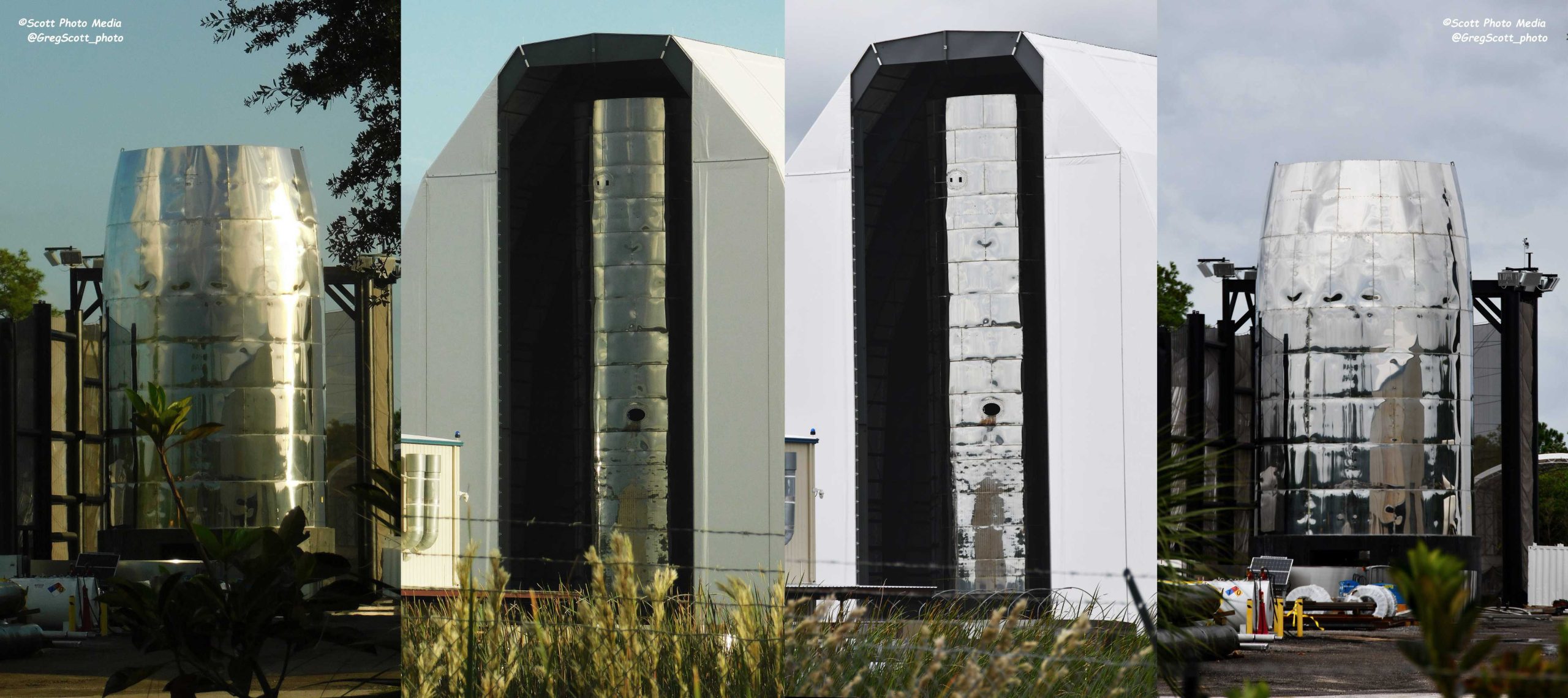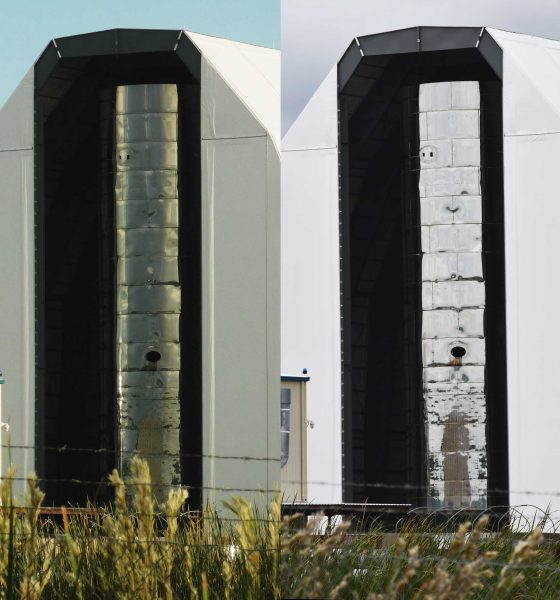

News
SpaceX’s Starship, Florida Space Coast make it through Hurricane Dorian unscathed
With Hurricane Dorian’s central Florida rendezvous essentially over, it’s safe to say that SpaceX’s Starship facilities and Florida’s Space Coast more generally have made it through the threatening storm almost completely unscathed.
SpaceX is simultaneously building two orbital-class Starship prototypes at separate facilities in Boca Chica, Texas and Cocoa, Florida, the latter of which was under threat from Hurricane Dorian and the former of which just made it through the remnants of Tropical Storm Fernand. Both facilities are where they are primarily because of their favorability relative to Earth’s orbital mechanics, but their locations also mean that SpaceX will have to deal with risks of hurricanes, tropical storms, and generally unsavory weather every summer.
Heading into the last few days of August, there was an increasingly high risk that Hurricane Dorian would pose an almost unprecedented threat to central Florida and the US East Coast, rapidly swelling from Category 3 to Cat 4. On September 1st, Dorian made landfall in the Bahama Islands and exploded into a record-breaking Category 5 storm with sustained wind speeds of more than 180 mph (285 km/h), making it the strongest hurricane to impact the region in recorded history.
As a collection of islands with a maximum surface height barely 30 meters (100 ft) above sea level, the storm wreaked havoc on the Bahamas, with storm surge appearing to inundate a majority of the several islands. In a tragic turn of events, the weather system pushing the storm west died off, effectively leaving the massive hurricane to listlessly pummel the Bahamas for a full 48 hours. Sadly, no fewer than 23 Bahamians have been killed by Hurricane Dorian, and damages to the island are immense and will likely take years to recover from.
Thus, it’s an incredibly bittersweet victory to know that the ~48 hours Dorian spent almost paused over the Bahamas can probably be credited with the storm’s dramatically reduced East Coast impact. As shown in the videos below, SpaceX is back in action at its Cocoa, Florida Starship assembly facility as of September 5th, almost entirely unscathed after Dorian weakened to a Category 2 storm and never made landfall in the state.
Without making landfall, the limited remaining impact of Dorian’s weakened storm surge and winds is unlikely to have resulted in significant damage to the string of launch pads located along Florida’s Space Coast, including two SpaceX pads (LC-40 and LC-39A). Had Dorian remained at its peak Category 5 strength and continued towards Florida unabated, the damage could have been immense. In particular, SpaceX’s Cocoa Starship facilities and hardware are almost entirely uncovered and unprotected from the elements, with almost two dozen massive steel rings at an exceptionally high risk of being tossed around like hula hoops if winds were high enough.
Those destructive winds never transpired in Florida – albeit at a great cost to the Bahamas – and it’s nearly impossible to discern between videos of the Starship facility taken before and after Dorian. More standing water is visible (yay, mosquitoes!) and SpaceX managed to roll the larger Starship Mk2 tank section inside a vertical assembly building partially completed just days prior, but all Starship hardware appears to have made it through the relatively mild weather untouched.
Check out Teslarati’s Marketplace! We offer Tesla accessories, including for the Tesla Cybertruck and Tesla Model 3.

News
Elon Musk’s Grokipedia surges to 5.6M articles, almost 79% of English Wikipedia
The explosive growth marks a major milestone for the AI-powered online encyclopedia, which was launched by Elon Musk’s xAI just months ago.

Elon Musk’s Grokipedia has grown to an impressive 5,615,201 articles as of today, closing in on 79% of the English Wikipedia’s current total of 7,119,376 articles.
The explosive growth marks a major milestone for the AI-powered online encyclopedia, which was launched by Elon Musk’s xAI just months ago. Needless to say, it would only be a matter of time before Grokipedia exceeds English Wikipedia in sheer volume.
Grokipedia’s rapid growth
xAI’s vision for Grokipedia emphasizes neutrality, while Grok’s reasoning capabilities allow for fast drafting and fact-checking. When Elon Musk announced the initiative in late September 2025, he noted that Grokipedia would be an improvement to Wikipedia because it would be designed to avoid bias.
At the time, Musk noted that Grokipedia “is a necessary step towards the xAI goal of understanding the Universe.”
Grokipedia was launched in late October, and while xAI was careful to list it only as Version 0.1 at the time, the online encyclopedia immediately earned praise. Wikipedia co-founder Larry Sanger highlighted the project’s innovative approach, noting how it leverages AI to fill knowledge gaps and enable rapid updates. Netizens also observed how Grokipedia tends to present articles in a more objective manner compared to Wikipedia, which is edited by humans.
Elon Musk’s ambitious plans
With 5,615,201 total articles, Grokipedia has now grown to almost 79% of English Wikipedia’s article base. This is incredibly quick, though Grokipedia remains text-only for now. xAI, for its part, has now updated the online encyclopedia’s iteration to v0.2.
Elon Musk has shared bold ideas for Grokipedia, including sending a record of the entire knowledge base to space as part of xAI’s mission to preserve and expand human understanding. At some point, Musk stated that Grokipedia will be renamed to Encyclopedia Galactica, and it will be sent to the cosmos.
“When Grokipedia is good enough (long way to go), we will change the name to Encyclopedia Galactica. It will be an open source distillation of all knowledge, including audio, images and video. Join xAI to help build the sci-fi version of the Library of Alexandria!” Musk wrote, adding in a later post that “Copies will be etched in stone and sent to the Moon, Mars and beyond. This time, it will not be lost.”
News
Tesla Model 3 becomes Netherlands’ best-selling used EV in 2025
More than one in ten second-hand electric cars sold in the country last year was a Tesla Model 3.

The Tesla Model 3 became the most popular used electric car in the Netherlands in 2025, cementing its dominance well beyond the country’s new-car market.
After years at the top of Dutch EV sales charts, the Model 3 now leads the country’s second-hand EV market by a wide margin, as record used-car purchases pushed electric vehicles further into the mainstream.
Model 3 takes a commanding lead
The Netherlands recorded more than 2.1 million used car sales last year, the highest level on record. Of those, roughly 4.8%, or about 102,000 vehicles, were electric. Within that growing segment, the Tesla Model 3 stood far ahead of its competitors.
In 2025 alone, 11,338 used Model 3s changed hands, giving the car an 11.1% share of the country’s entire used EV market. That means more than one in ten second-hand electric cars sold in the country last year was a Tesla Model 3, Auto Week Netherlands reported. The scale of its lead is striking: the gap between the Model 3 and the second-place finisher, the Volkswagen ID3, is more than 6,700 vehicles.
Rivals trail as residual values shape rankings
The Volkswagen ID.3 ranked a distant second, with 4,595 used units sold and a 4.5% market share. Close behind was the Audi e-tron, which placed third with 4,236 registrations. As noted by Auto Week Netherlands, relatively low residual values likely boosted the e-tron’s appeal in the used market, despite its higher original price.
Other strong performers included the Kia Niro, the Tesla Model Y, and the Hyundai Kona, highlighting continued demand for compact and midsize electric vehicles with proven range and reliability. No other model, however, came close to matching the Model 3’s scale or market presence.
News
Tesla Model Y Standard Long Range RWD launches in Europe
The update was announced by Tesla Europe & Middle East in a post on its official social media account on X.

Tesla has expanded the Model Y lineup in Europe with the introduction of the Standard Long Range RWD variant, which offers an impressive 657 km of WLTP range.
The update was announced by Tesla Europe & Middle East in a post on its official social media account on X.
Model Y Standard Long Range RWD Details
Tesla Europe & Middle East highlighted some of the Model Y Standard Long Range RWD’s most notable specs, from its 657 km of WLTP range to its 2,118 liters of cargo volume. More importantly, Tesla also noted that the newly released variant only consumes 12.7 kWh per 100 km, making it the most efficient Model Y to date.
The Model Y Standard provides a lower entry point for consumers who wish to enter the Tesla ecosystem at the lowest possible price. While the Model 3 Standard is still more affordable, some consumers might prefer the Model Y Standard due to its larger size and crossover form factor. The fact that the Model Y Standard is equipped with Tesla’s AI4 computer also makes it ready for FSD’s eventual rollout to the region.
Top Gear’s Model Y Standard review
Top Gear‘s recent review of the Tesla Model Y Standard highlighted some of the vehicle’s most notable features, such as its impressive real-world range, stellar infotainment system, and spacious interior. As per the publication, the Model Y Standard still retains a lot of what makes Tesla’s vehicles well-rounded, even if it’s been equipped with a simplified interior.
Top Gear compared the Model Y Standard to its rivals in the same segment. “The introduction of the Standard trim brings the Model Y in line with the entry price of most of its closest competition. In fact, it’s actually cheaper than a Peugeot e-3008 and costs £5k less than an entry-level Audi Q4 e-tron. It also makes the Ford Mustang Mach-E look a little short with its higher entry price and worse range,” the publication wrote.








